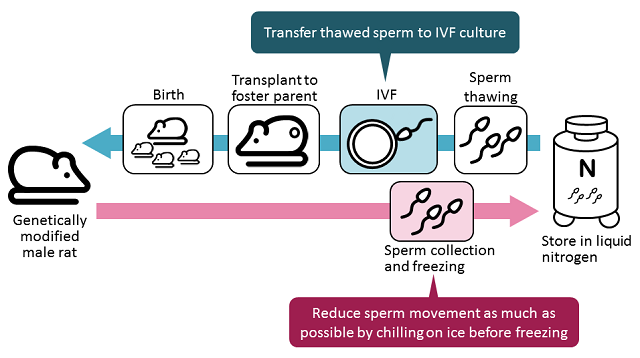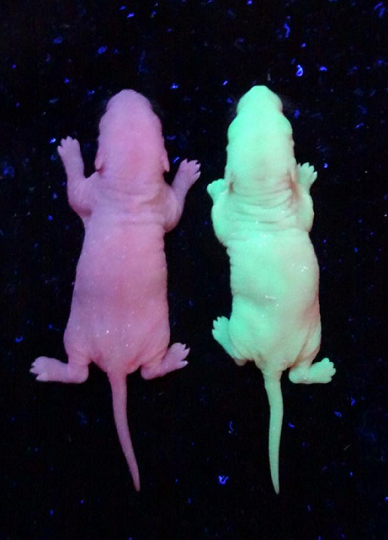Efficient cryopreservation of genetically modified rat spermatozoa
Researchers at Kumamoto University have developed a new technique to improve the efficiency of rat sperm cryopreservation, a process that is usually extremely difficult. Their technique makes it possible to produce more than 300 offspring from one male rat through in vitro fertilization using frozen sperm. It can be used to maintain specific strains of genetically modified rats that are in high demand for medical research.Rat spermatozoa are two to four times larger than that of other animal species and are easily damaged by changes in pH, osmotic pressure, and temperature. Because these animals are very frequently used in medical research, a cryopreservation method was developed nearly 20 years ago. However, rat spermatozoa motility after thawing is extremely poor, and unless artificial insemination is performed at night (10:00-11:00 pm) no offspring will be produced. Furthermore, the number of offspring produced after successful artificial insemination is often lower than normal so the cryopreservation of rat sperm is not typically considered practical.
To improve cryopreservation methods, Professor Nakagata and Dr. Takeo of the Center for Animal Resources and Development (CARD) at Kumamoto University, Japan have been searching for methods to retain sperm mobility after thawing. They knew that the freezing process significantly reduced sperm motility, so they attempted to chill the sperm first to reduce movement as much as possible before freezing.
They tested their cryopreservation method on a type of genetically modified rat (EGFP rat) sperm that emits green fluorescence and then used it for in vitro fertilization. Surprisingly, the fertilization rate exceeded 80% and the experiment successfully produced over 300 offspring from the sperm of one male rat.
Sperm cryopreservation is easier than the cryopreservation of fertilized eggs, and many cells (50 - 100 million) can be obtained from a single male rat. In recent years, genetically modified rats useful for human disease research have been produced using genome editing technology. This indicates that there is a need for an efficient technique to preserve genetically modified rat strains. The cryopreservation technology developed here can provide an efficient storage method of genetically modified rats and could accelerate the development of treatments for intractable diseases.
"Compared to mice, rats are about ten times the size, require a larger housing space, and simply cost more to keep. There is a need to reduce the amount of space they take up and their cost for research labs," said Professor Nakagata. "Our cryopreservation technique is likely to be very useful in the preservation of genetically modified rat strains. We believe that it could become a new global standard for research resources."
This research was posted online in "Scientific Reports" on 9 January 2020.
[Source]
Nakagata, N., Mikoda, N., Nakao, S., Nakatsukasa, E., & Takeo, T. (2020). Establishment of sperm cryopreservation and in vitro fertilisation protocols for rats. Scientific Reports, 10(1). doi:10.1038/s41598-019-57090-7
[Publication URL]
https://www.nature.com/articles/s41598-019-57090-7
[KU PR URL]
https://www.kumamoto-u.ac.jp/whatsnew/seimei-sentankenkyu/20200114
[Fund(s)]
1) Grants for Research on Development of New Drugs from the Japan Agency for Medical Research and Development (AMED), 2) The Collaborative Research Project of the Brain Research Institute at Niigata University, 3) Collaborative Research Project between Kumamoto University and Kyudo Co. Ltd.
[Number(s)]
1) 16769865, 2) 2019-15, 3) NA
[Twitter Engagement]
#Kumamoto_University #CARD researchers work out efficient #cryopreservation of rat spermatozoa—an important finding for efficiently producing genetically modified rats for research. Paper: http://bit.ly/Cryopreserve
[Image details]
CREDIT:
Professor Naomi Nakagata
USAGE RESTRICTIONS:
This image may only be used in conjunction with the accompanying release, or stories written about the work described in the release with reference to the original work.
[Media 1]

Rat sperm
Image of a single rat spermatozoa. Total length: about 200μm
[Media 2]

Offspring production system from frozen rat sperm
The newly developed cryopreservation technique for rat spermatozoa requires sperm movement to be reduced as much as possible before freezing in liquid nitrogen. This technique greatly improves the in vitro fertilization and birth rates.
[Media 3]

EGFP frozen sperm-derived rat offspring (right offspring emitting green fluorescence)
Researchers from Kumamoto University in Japan used their new cryopreservation technique to successfully produce many offspring from the sperm of a single male rat through in vitro fertilization. The method works by preserving the motility of rat sperm even after being frozen.
